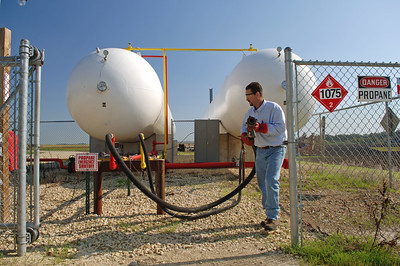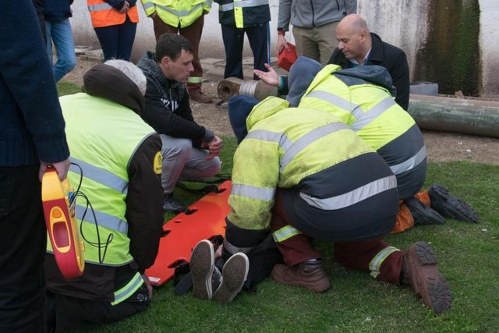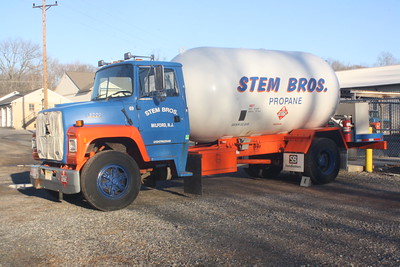
Propane is technically a liquid, but it has a boiling point, just like any other liquid. A bucket filled with water just sits there. However, once the water is heated to 212° F by a fire, it begins to boil and water vapor escapes. The water eventually evaporates and the bucket becomes empty.
The boiling point of propane is -44° F. So, if you had a bucket of propane and the temperature outside was 50 or 60 degrees Fahrenheit, it would not evaporate. However, once it exceeds that temperature, it will boil, the gas will evaporate, and you will end up with an empty bucket. However, there will be no place for the propane to evaporate if we pump it into an enclosed cylinder. We do, however, want to use some of the evaporated gas to power our propane appliances, and there is a way to do so.
By filling a propane cylinder to no more than 80%, an open area above the surface of the liquid propane can accumulate evaporating gasses. A small amount of liquid propane will expand into a large amount of propane gas, which is what we want.
In general propane evaporate easily because it has low boiling point of -44°F and makes it vaporize as soon as it is released from its pressurized container.
Its Physical Property
Propane is a hydrocarbon gas that is stored as a liquid under pressure and at low temperatures. The low boiling point and high vapor pressure of propane make it evaporate easily.
Propane has a boiling point of -44°F, which means it will vaporize and convert into a gas when exposed to temperatures above this point. The vapor pressure of propane is the pressure exerted by the gas above its liquid form, and it is also an important factor in determining how easily propane will evaporate. The higher the vapor pressure, the more readily propane will convert from a liquid to a gas.
Propane also has a low density compared to other liquids, meaning it will vaporize more quickly when exposed to the same temperature and pressure as a denser liquid.
In addition to its low boiling point and high vapor pressure, the rate of propane evaporation can also be influenced by external factors such as exposure to sunlight, changes in atmospheric pressure, and humidity. By keeping the propane tank within the recommended temperature range, and taking steps to minimize evaporation, you can ensure a safe and efficient supply of propane.
How Does Propane Turn from Liquid to Gas?
To understand how propane turns from a liquid to a gas, it is important to first understand the basics of matter. All matter is made up of atoms that are in constant motion. The type of matter (solid, liquid, or gas) is determined by how fast the atoms are moving. In a solid, the atoms are closely packed together and are not moving very fast.
In a liquid, the atoms are further apart than in a solid, but are still close together and are moving faster than in a solid. In a gas, the atoms are far apart and are moving very fast. So, when you have a bottle of propane (or any other liquid), the atoms that make up the propane are closer together than they would be if the propane were a gas. When you open the bottle, some of the energy that was keeping the atoms close together is released, and the atoms start to move further apart. As the atoms move further apart, they start to move faster. And as they move faster, they take up more space.
That’s why a gas takes up more space than a liquid – because the atoms that make up a gas are moving around much faster than those in a liquid. Eventually, all of the propane will turn into a gas. But it will take some time for all of it to happen – especially if you’re not giving it any help (like heating it up).
To boil, the liquid Propane absorbs heat from the steel walls of the gas bottle, which absorb heat from the surrounding air. When you turn on your gas appliance and release some of the pressure in the gas bottle, the Propane liquid boils and turns back into gas vapor. As with water, the more heat applied, the faster it boils, causing it to vaporize. The vapor pressure in the bottle rises with temperature. As the steel of the bottle absorbs heat from the surrounding air, cold weather slows the rate of vaporization.
Vaporization also causes the gas bottle to feel colder than the ambient temperature. The gas bottle becomes even colder when you use it.
What happens if water comes into contact with propane?
Since the boiling point of propane is around -42 °C, the water simply freezes. The propane absorbed heat energy from the water (normal temperature +25°C) and vaporized, while the water began to cool as it lost heat energy. If this phenomenon continues, the water will freeze (the freezing temperature of water is 0°C). So, based on these properties, we can conclude that if a propane leak (in liquid form) occurs, we should avoid using a direct water jet/spray on the leaked gas because it will accelerate the vaporization process, potentially leading to vapor cloud formation. Rather, we can reduce the temperature of the container body by spraying it with water.
Does Propane Evaporate in Winter?
Yes, propane does evaporate in winter. However, the rate at which it evaporates is much slower than in summer. This is due to the fact that the temperature of the air is much colder in winter, which slows down the evaporation process. Freezing temperatures, in particular, have two negative effects on propane.
Propane Depletion
When the temperature drops, the amount of propane inside the tank can be drastically reduced. Because of the unforgiving winter cold, propane shrinks, leaving an unsuspecting person surprised to find the tank level gauge reading far below what it did before the winter hit. Once the tank is depleted, the only option is to refill it, wasting both time and money.
Loss of Tank Pressure
In cold weather, the pressure within a propane tank will also drop dramatically. Propane is stored in the tank as a liquid and then released as gas through a valve. However, when temperatures within the tank fall below -44 degrees Fahrenheit, the propane loses its ability to convert into a gaseous state.
Recommended Storage Temperature
The recommended storage temperature for a propane tank is between -44°F and 120°F. Propane is stored as a liquid under pressure and at low temperatures, and higher temperatures can cause the propane to evaporate more quickly. By keeping the tank within the recommended temperature range, you can minimize evaporation and ensure a safe and efficient supply of propane for your home or business.
It is important to note that extreme temperature fluctuations should be avoided, as they can cause stress on the tank and potentially lead to leaks or other safety hazards. In addition, it is recommended to store propane tanks in a shaded area, as direct sunlight can cause the temperature inside the tank to increase, which will result in faster evaporation.
To Make a Conclusion
Propane evaporates easily due to its physical properties and the conditions under which it is stored. The rate of evaporation depends on several factors, including temperature, pressure, exposure to sunlight, and humidity. High temperatures, overfilled tanks, direct sunlight, and high humidity levels can all cause propane to evaporate more quickly.
Minimizing propane evaporation is important for ensuring a safe and efficient supply of propane for your home or business. Proper storage of propane tanks, use of proper fittings and valves, keeping the tank within the recommended temperature range, using a propane tank cover, and regular maintenance are all effective ways to minimize evaporation.
By understanding the reasons behind propane evaporation and taking steps to minimize it, you can ensure a reliable and cost-effective supply of propane for your needs.

Mike is an experienced propane technician with over 15 years of professional experience in the field. He has dedicated his career to helping customers with their propane needs, from installation to maintenance and repair. Together with Jeremy, he co-founded this website to provide useful information and guidance to customers seeking reliable propane services.



